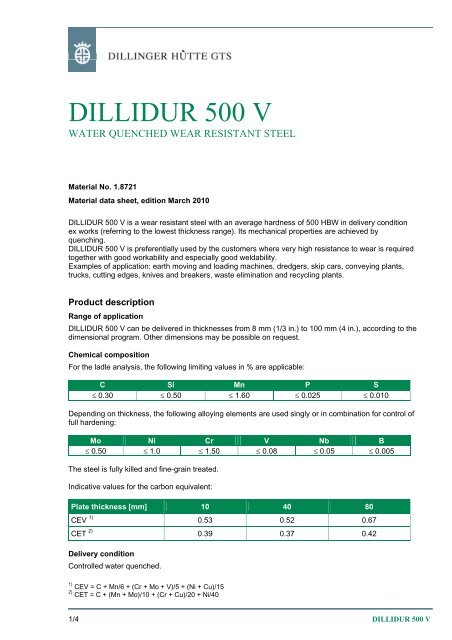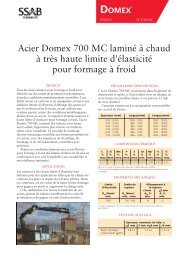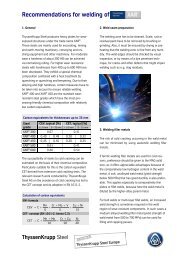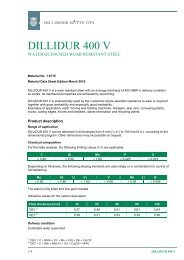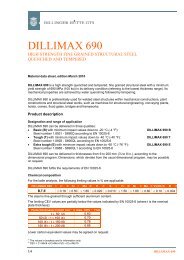DILLIDUR 500 V - High Strength Plates & Profiles Inc.
DILLIDUR 500 V - High Strength Plates & Profiles Inc.
DILLIDUR 500 V - High Strength Plates & Profiles Inc.
Create successful ePaper yourself
Turn your PDF publications into a flip-book with our unique Google optimized e-Paper software.
<strong>DILLIDUR</strong> <strong>500</strong> V<br />
WATER QUENCHED WEAR RESISTANT STEEL<br />
Material No. 1.8721<br />
Material data sheet, edition March 2010<br />
<strong>DILLIDUR</strong> <strong>500</strong> V is a wear resistant steel with an average hardness of <strong>500</strong> HBW in delivery condition<br />
ex works (referring to the lowest thickness range). Its mechanical properties are achieved by<br />
quenching.<br />
<strong>DILLIDUR</strong> <strong>500</strong> V is preferentially used by the customers where very high resistance to wear is required<br />
together with good workability and especially good weldability.<br />
Examples of application: earth moving and loading machines, dredgers, skip cars, conveying plants,<br />
trucks, cutting edges, knives and breakers, waste elimination and recycling plants.<br />
Product description<br />
Range of application<br />
<strong>DILLIDUR</strong> <strong>500</strong> V can be delivered in thicknesses from 8 mm (1/3 in.) to 100 mm (4 in.), according to the<br />
dimensional program. Other dimensions may be possible on request.<br />
Chemical composition<br />
For the ladle analysis, the following limiting values in % are applicable:<br />
C Si Mn P S<br />
≤ 0.30 ≤ 0.50 ≤ 1.60 ≤ 0.025 ≤ 0.010<br />
Depending on thickness, the following alloying elements are used singly or in combination for control of<br />
full hardening:<br />
Mo Ni Cr V Nb B<br />
≤ 0.50 ≤ 1.0 ≤ 1.50 ≤ 0.08 ≤ 0.05 ≤ 0.005<br />
The steel is fully killed and fine-grain treated.<br />
Indicative values for the carbon equivalent:<br />
Plate thickness [mm] 10 40 80<br />
CEV 1) 0.53 0.52 0.67<br />
CET 2) 0.39 0.37 0.42<br />
Delivery condition<br />
Controlled water quenched.<br />
1) CEV = C + Mn/6 + (Cr + Mo + V)/5 + (Ni + Cu)/15<br />
2) CET = C + (Mn + Mo)/10 + (Cr + Cu)/20 + Ni/40<br />
1/4 <strong>DILLIDUR</strong> <strong>500</strong> V
Mechanical properties in the delivery condition<br />
Hardness<br />
Surface hardness at room temperature:<br />
470 - 530 HBW for plate thicknesses ≤ 30 mm<br />
450 - 530 HBW for plate thicknesses > 30 mm<br />
Tensile testing on transverse specimens at room temperature (indicative values for 20 mm<br />
(0.8 in.) plate thickness)<br />
Tensile strength 1600 MPa (232 ksi)<br />
Yield point 1100 MPa (160 ksi)<br />
Elongation 9 % (lo = 5.65√So)<br />
In spite of their high tensile properties, <strong>DILLIDUR</strong> steels are not intended for safety relevant<br />
components. For this purpose high strength steels DILLIMAX are available.<br />
Charpy-V impact test on longitudinal specimens (indicative values for 20 mm (0.8 in.) plate<br />
thickness)<br />
Toughness 25 J at -20 °C (-4 °F)<br />
Testing<br />
Brinell surface hardness tested once per heat and 40 t.<br />
Identification of plates<br />
Unless otherwise agreed the marking is carried out via steel stamps with at least the following<br />
information:<br />
• steel grade (<strong>DILLIDUR</strong> <strong>500</strong> V)<br />
• heat number<br />
• number of mother plate and individual plate<br />
• the manufacturer’s symbol<br />
• inspector’s sign<br />
Processing<br />
The entire processing and application techniques are of fundamental importance to the reliability of the<br />
products made from this steel. The user should ensure that his design, construction and processing<br />
methods are aligned with the material, correspond to the state-of-the-art that the fabricator has to<br />
comply with and are suitable for the intended use. The customer is responsible for the selection of the<br />
material. The recommendations in accordance with EN 1011-2 (Welding) and CEN/TR 10347 (Forming)<br />
as well as recommendations regarding job safety in accordance with national rules should be observed<br />
while considering the higher strength and hardenability.<br />
Cold forming<br />
<strong>DILLIDUR</strong> <strong>500</strong> V can be cold formed by bending in spite of its high hardness and strength. It should be<br />
paid attention to the fact that with increasing yield strength, the required forces for the forming operation<br />
also increase, even if the plate thickness remains unchanged. The spring-back also increases. Grinding<br />
of the flame cut or sheared edges in the bending area is recommended to avoid crack initiation. In order<br />
to avoid the risk of cracking from the edges, flame cut or sheared edges should be ground in the area<br />
that is to be cold formed. It is also advisable to round the plate edge slightly on the outside of the bend<br />
coming under tension stress during bending.<br />
2/4 <strong>DILLIDUR</strong> <strong>500</strong> V
During the processing, the necessary safety measures have to be taken, so that nobody will be<br />
exposed to a danger by a possible fracture of the work piece during the forming process.<br />
The following geometries can usually be achieved by cold forming without the formation of surface<br />
defects (where t is the plate thickness) :<br />
Minimum bending radius Minimum die opening<br />
Transverse direction 7 t 16 t<br />
Longitudinal direction 9 t 20 t<br />
Hot forming<br />
Since <strong>DILLIDUR</strong> <strong>500</strong> V obtains its hardness by accelerated cooling from the austenitizing temperature,<br />
hot forming without major hardness loss is only possible if a renewed quenching treatment is carried out<br />
after forming. However, the hardness achieved by means of such a treatment may differ from that<br />
measured in the delivery condition. This is due to the fact that the cooling conditions at the fabricator’s<br />
works are generally less adequate than those available during plate production.<br />
The steel can be heated to about 200 °C (390 °F) without any substantial drop in hardness.<br />
Flame cutting and welding<br />
For flame cutting, the following minimum temperatures should be observed: 60 °C (140 °F) for plate<br />
thicknesses up to 26 mm, 120 °C (248 °F) for plate thicknesses from 26 up to 70 mm and 150 °C<br />
(302 °F) for thicker plates.<br />
For manual arc welding, basic coated rods with very low residual moisture should be used (and dried if<br />
necessary according to the manufacturer’s instructions).<br />
Additionally the following recommendations are to be considered:<br />
• For more information about preheating of <strong>DILLIDUR</strong> <strong>500</strong> V, please refer to our technical information<br />
“THE CONCEPT TO COMBAT WEAR AND TEAR – <strong>DILLIDUR</strong>”. Preheating above 200 °C (390 °F)<br />
must however be avoided, because it could cause a decrease of the hardness (see diagram).<br />
• Weld metals with low yield strength are preferred for tack, root and filler passes. If welds are<br />
exposed to wear, only the final passes should be welded with consumables producing a hardness<br />
matching the parent plate.<br />
Heat treatment<br />
The following diagram shows the general changes in hardness or strength values in accordance with<br />
the heat treatment temperature:<br />
Hardness [HBW] resp. Rm and Rp0,2 [MPa]<br />
1800<br />
1600<br />
1400<br />
1200<br />
1000<br />
800<br />
600<br />
400<br />
200<br />
Tensile strength<br />
Yield strength<br />
Hardness<br />
Indicative values for 20 mm plate<br />
Nominal hardness in the delivery condition<br />
0<br />
0 100 200 300 400 <strong>500</strong> 600<br />
Tempering temperature [°C]<br />
3/4 <strong>DILLIDUR</strong> <strong>500</strong> V
Machining<br />
<strong>DILLIDUR</strong> <strong>500</strong> V can be machined with HSS-drills and especially with HSS-Co-alloyed drills with a<br />
satisfactory service life if the drill advance and cutting speed are correspondingly accommodated.<br />
General technical delivery requirements<br />
Unless otherwise agreed, the general technical requirements in accordance with EN 10021 are<br />
applicable.<br />
Tolerances<br />
Unless otherwise agreed, the tolerances are in accordance with EN 10029, with class A for thickness.<br />
Surface quality<br />
Unless otherwise agreed, the provisions in accordance with EN 10163-2, class A2 are applicable.<br />
General note<br />
If particular requirements are demanded and not covered in this data sheet, please contact us with the<br />
specifications for our review and agreement prior to ordering. The information in this data sheet is a<br />
product description. This data sheet is updated at occasion demands. The latest version is available<br />
from the mill or as download at www.dillinger.de.<br />
For more information about application and processing of <strong>DILLIDUR</strong> <strong>500</strong> V, please refer to our<br />
technical information “THE CONCEPT TO COMBAT WEAR AND TEAR – <strong>DILLIDUR</strong>”.<br />
Distribution<br />
For your local representative<br />
please contact our coordination office in Dillingen:<br />
Telephone: +49 6831 47 22 23<br />
Fax: +49 6831 47 33 50<br />
or the internet:<br />
http://www.dillinger.de/dh/kontakt/weltweit/index.shtml.en<br />
AG der Dillinger Hüttenwerke<br />
Postfach 1580<br />
D-66748 Dillingen/Saar<br />
e-mail: info@dillinger.biz<br />
http://www.dillinger.de<br />
Telephone: +49 6831 47 21 46<br />
Fax: +49 6831 47 30 89<br />
4/4 <strong>DILLIDUR</strong> <strong>500</strong> V


